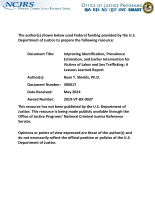Early intervention
Police Early Intervention Systems: The State of the Art
How Should We Identify and Intervene With Youth at Risk of Joining Gangs? A Developmental Approach for Children Ages 0-12
Population-level Effects on Crime of Recovering Firearms from Armed Prohibited Persons: Intention-to-treat Analysis of a Pragmatic Cluster-randomised Trial in California Cities
Problem Officers and Problem Behavior: On the Object of Early Intervention Systems
Understanding and Reducing Deaths in Custody: Analysis of the Bureau of Justice Assistance Death in Custody Reporting Act (DCRA) Data
Salt Lake City's Comprehensive Communities Pregram: A Case Study
Using a Serious Drug Abuser Scale in the Criminal Justice System: Final Report, Expanding Applications of Drug Use Forecasting Data in New York
Early Intervention for Victims of Crime: Evaluation of Skills for Psychological Recovery
Using Scammers’ Data to Estimate the Impact and Importance of Preventing Repeat Mail Fraud Victimization
Improving Identification, Prevalence Estimation, and Earlier Intervention for Victims of Labor and Sex Trafficking: A Lessons Learned Report
Evaluation of California's Armed and Prohibited Persons System Study Protocol for a Cluster-Randomized Trial
Does Exotic Dancing Lead to Prostitution? An Exploratory Study
Integrated Health Care and Criminal Justice Data Viewing the Intersection of Public Safety, Public Health, and Public Policy Through a New Lens: Lessons From Camden, New Jersey
Home Visiting for Adolescent Mothers: Effects on Parenting, Maternal Life Course, and Primary Care Linkage
Project STRONG: an Online, Parent-Son Intervention for the Prevention of Dating Violence among Early Adolescent Boys
Brief Validated Screen to Identify Boys and Girls at Risk for Early Marijuana Use
Addressing Student Mental Health Concerns - Breakout Session, NIJ Virtual Conference on School Safety
On February 16-18, 2021, the National Institute of Justice hosted the Virtual Conference on School Safety: Bridging Research to Practice to Safeguard Our Schools. This video includes the following presentations:
See the YouTube Terms of Service and Google Privacy Policy





